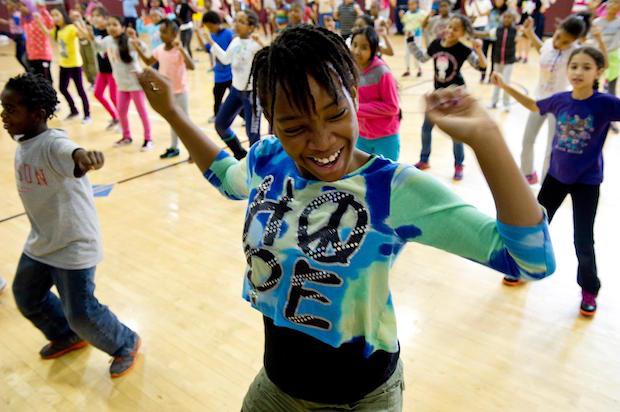Spotlight on CityDance DREAM

For nearly 20 years, CityDance has been a dynamo for dance and arts education in the Washington, DC metro area. The company views dance not just as an aesthetic pursuit but an activist one. Through its diverse programs it invests in the community by--as the director of its flagship arts education program CityDance DREAM Kelli Quinn put it--using dance to "support our students' emotion, physical, social, and cognitive needs." It's this understanding that transforming a community starts with transforming and activating the young people who are the future of that community that garnered the DREAM program a 2015 National Arts and Humanities Youth Program award. As First Lady Michelle Obama said at the November awards ceremony, "Thousands of kids all across America are dreaming just a little bigger and they’re reaching a little higher thanks to after-school programs that you all represent." Here's more from Kelli Quinn about how CityDance DREAM is helping the youth of our nation's capital to dream big.
NEA: In your own words, what’s the mission of the CityDance DREAM project?
KELLI QUINN: Our mission is to invest in the lives of youth and support them in their growth toward college.
NEA: What was the that led to the creation of the DREAM program, and how does it fit into CityDance’s overall mission?
QUINN: The CityDance DREAM program was started because we saw that underserved Washington, DC communities were lacking access to the arts for youth. At the core of CityDance’s overall mission is to transform lives through dance. Through the CityDance DREAM program we are able to support youth to be successful in life and discover their full potential.
NEA: Can you please describe the community that you serve and talk about the goal of the program?
QUINN: Our programs are currently located at six DC public schools and a community center serving 160 students in grades three through 12. Our student population is 70 percent African American and 30 percent Hispanic. The goal is for all of our students to graduate high school. We use dance to support our students’ emotional, physical, social, and cognitive needs.
NEA: How is the program structured?
QUINN: The CityDance DREAM program provides dance classes and performances, mentoring, and tutoring. Dance classes include hip hop, modern, ballet, and cultural dance forms. Students in the program take weekly dance classes, attend professional dance performances, participate in a school-to-school pen pal program, develop community service projects, and perform several times throughout the year with the highlight being their annual performance at a Washington Wizards half-time [show] with 160 of their peers. Middle and high-school students take an annual spring break trip to New York City, participate in summer internships with CityDance via the DC Summer Youth Employment program, and receive academic support, including college prep.
NEA: Why do you think dance is a good vehicle for reaching and empowering young people? What do you expect students to put into the program? What do you expect them to get out of it?
QUINN: Dance is a unique art form that addresses the whole child and engages them in both a personal and collaborative way. We expect our students to commit to energy and interest to the program and classes. We hope that the program will help them to build their confidence and communication skills, and gain respect, integrity, self worth, responsibility, passion, creativity, and a sense of connection with the community and the group.
NEA: What are some of the challenges of the program—at a participant level and at a program/organization level? What have been some unexpected or surprising outcomes?
QUINN: We know that our program is having an impact on our students and that we can do more. We were recently selected by Washington, DC Mayor Muriel Bowser to anchor a new arts and cultural center in downtown DC. This site will become a home for our DREAM program--allowing us to triple the number of students we serve and to significantly deepen our more academic, family and college readiness services to our students.
As we built the program, we found that the outcomes we were seeking to meet with our third- through fifth-graders were being met so strongly that they didn’t want to leave the program. We wanted to provide programming that continued to support them from elementary to middle and middle to high school. Those relationships that were built between students and staff inspired us to make a longer commitment to our students and expand the program so students can participate through twelfth grade.
NEA: From your point of view, what does success look like for the program? Is there a particular success story that stands out?
QUINN: Success looks like supporting our students in reaching their full potential and graduating high school, and providing them with dance programming that supports their life. One of our success stories is Valeria who started with DREAM seven years ago when she was in fifth grade. In seventh grade she began to have trouble academically and her school wanted to pull her out of dance--yet dance was the one thing in her life that kept her coming to school. We began tutoring Valeria so she could get her grades up and stay in dance. This was what sparked our expanded vision for what we wanted to do with the DREAM program—to transform young lives through dance. Valeria is now in twelfth grade and we are helping her prepare to go to college.




